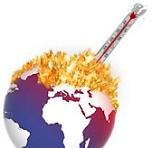
 |
EARTH'S TEMPERATURE NEAR HIGHEST LEVEL
|
|---|
| Earth may nearing its warmest level in the last million years according to a paper published by NASA scientists in the Proceedings of the National Academy of Sciences. James Hansen of NASA's Goddard Institute for Space Studies in New York City and colleagues report that. "Earth is now reaching and passing through the warmest levels in the current interglacial period"and that global temperature may be within one degree Celsius (1.8°F) of the maximum temperature of the past million years. "That means that further global warming of 1 degree Celsius defines a critical level. If warming is kept less than that, effects of global warming may be relatively manageable," said Hansen. |

|
|---|
"During the warmest interglacial periods the Earth was reasonably similar to today. But if further global warming reaches 2 or 3 degrees Celsius, we will likely see changes that make Earth a different planet than the one we know. The last time it was that warm was in the middle Pliocene, about three million years ago, when sea level was estimated to have been about 25 meters (80 feet) higher than today."
|
|---|
TEMPERATUR
Temperature is a measure of how easily an object gives up or receives heat. Heat will always flow naturally from an object with a higher temperature to an object with a lower temperature.
Thermometers measure temperature in various units. A metric unit known as the degree Celsius (°C) is in general use throughout the world. Another metric unit, the kelvin (K), is used in some scientific work. In the United States, people use the nonmetric degree Fahrenheit (°F) for most commercial and everyday purposes.
The unit 1 °F equals 5/9 of the unit 1 °C, and a temperature measurement of 32 °F equals a measurement of 0 °C. So you can use the following equation to convert a temperature measured in degrees Fahrenheit to one measured in degrees Celsius: °C = (°F - 32) X (5/9).
The unit 1 K is exactly the same as the unit 1 °C, and a measurement of 273.15 K equals a measurement of 0 °C. Thus, you can use the following equation to convert a temperature measured in kelvins to one measured in degrees Celsius: °C = K - 273.15. The International System of Units (SI), the modern metric system, uses this equation to define the Celsius scale in terms of the kelvin scale.
 |
 |
|---|
|
||||||||||||
|---|---|---|---|---|---|---|---|---|---|---|---|---|
|
|
||||||||||||